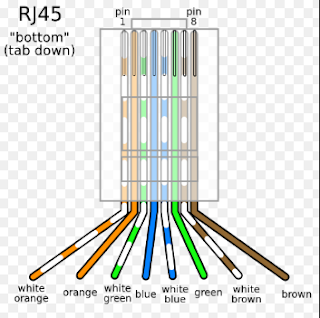The cable and connector specifications used to support Ethernet implementations are derived from the EIA/TIA standards body. There are many network connectors:
- RJ-11 is a physical interface often used for terminating telephone wires. It is probably the most familiar of the registered jacks, being used for single line telephone jacks in most homes across the world.
- RJ-45 is slightly larger than RJ-11 phone connectors and jacks.
- Attachment Unit Interface (AUI connectors): is a 15 pin connection that provides a path between a node's Ethernet interface and the Medium Attachment Unit (MAU), sometimes known as a transceiver.
- Gigabit Interface Converter (GBIC): a hot-swappable I/O device that plugs into a Gigabit Ethernet port. GBICs are used in the LAN for uplinks and are normally used for the backbone.
- fiber-optic GBIC: a transceiver that acts as electrical current/optical signal converter.
- Mini GBIC: A variation of the GBIC called the small form-factor pluggable transceiver (SFP), also known as mini-GBIC, has the same functionality but in a smaller form factor.
When choosing Ethernet cable types, maximum segment length and speed are the most important factors. The following table compares the most common Ethernet cables.
Cable Type Comparison
| Media Type | Maximum Segment Length | Speed | Cost | Advantages | Disadvantages |
| UTP | 100 m | 10 Mbps to 1000 Mbps | Least expensive | Easy to install; widely available and widely used | Susceptible to interference; can cover only a limited distance |
| STP | 100 m | 10 Mbps to 100 Mbps | More expensive than UTP | Reduced crosstalk; more resistant to EMI than Thinnet or UTP | Difficult to work with; can cover only a limited distance |
| Coaxial | 500 m (Thicknet)185 m (Thinnet) | 10 Mbps to 100 Mbps | Relatively inexpensive, but more costly than UTP | Less susceptible to EMI interference than other types of copper media | Difficult to work with (Thicknet); limited bandwidth; limited application (Thinnet); damage to cable can bring down entire network |
| Fiber-Optic | 10 km and farther (single-mode)2 km and farther (multimode) | 100 Mbps to 100 Gbps (single mode)100 Mbps to 9.92 Gbps (multimode) | Expensive | Cannot be tapped, so security is better; can be used over great distances; is not susceptible to EMI; has a higher data rate than coaxial and twisted-pair cable | Difficult to terminate |
CCENT have many questions about UTP cable and the the categories of UTP cable, therefore, we will talk more about this topic.
Unshielded Twisted Pair (UTP) is a cable that has four pairs of wires twisted inside it to eliminate electrical interference. EIA/TIA standards body specifies an RJ-45 connector for UTP cable. RJ-45 connector is the most common type of connection media, which have eight connector pins. UTP cable has a small external diameter of 0.43 cm, make it easy to install.
 |
Unshielded Twisted Pair (UTP)
|
 |
| RJ-45 Pins |
The categories of cabling defined for Ethernet are derived from the EIA/TIA-568 (SP-2840) Commercial Building Telecommunications Wiring standards. Here is the category of UTP cable:
- Category 1: Previously used for POTS telephone communications, ISDN and doorbell wiring.
- Category 2: Previously was frequently used on 4 Mbit/s token ring networks.
- Category 3: the standard cable for use with Ethernet 10Base-T, capable of transmit data at speeds up to 10 Mbps.
- Category 4: no longer common or used in new installations, was frequently used on 16 Mbit/s token ring networks.
- Category 5: standard cable for use with Ethernet 100Base-TX, capable of transmitting data at speeds up to 100 Mbps.
- Category 5e: standard cable for use with Ethernet 1000Base-T, capable of transmitting data at speeds up to 1000 Mbps.
- Category 6: Consists of 4 pairs of 23-gauge copper wires, which can transmit data at speeds of up to 1000 Mbps. Notice the EIA/TIA standards for Category 6 cables require 23AWG, NOT 24 AWG.
 |
| cat5e cable |
ICND1 and ICND2 break down








This information is well but if you using cables you must buy from smartect cables specialy its cat6 plenum because i am also use this and i am very satisfied and they also provide 1000ft cables this is a new brand and it gives cheap price with good quality
ReplyDeleteHey, Great informative blog; I'd also like to share my best experience with DINTEK Electronics Ltd, a manufacturing company based in Taipei, Taiwan that provides the best cable management products, including Category 6a cable , fibre optic cable , fibre optic connectors , and many others, at reasonable prices and of the highest quality. I placed an order there and received it in just four days with excellent packaging.
ReplyDeleteYou should give it a shot. Thank you very much.
When , we talk about Internet Connection / broadband Services ,
ReplyDeleteTPG Phone Number .
Great information!! Thanks for sharing this informative information. I am looking for more updates in the future. Keep it up.
ReplyDeleteWhen you invest in Cat 6A cable, you’re deciding to support your organization and its technology infrastructure for the long term. DINTEK Electronic Ltd provides Category 6A Cable that can support a full 100 m distance across the entire channel. It is designed to support 10G networks and long-term planning for workstation areas. For more, visit us: www.dintek.com.tw
check more
ReplyDelete